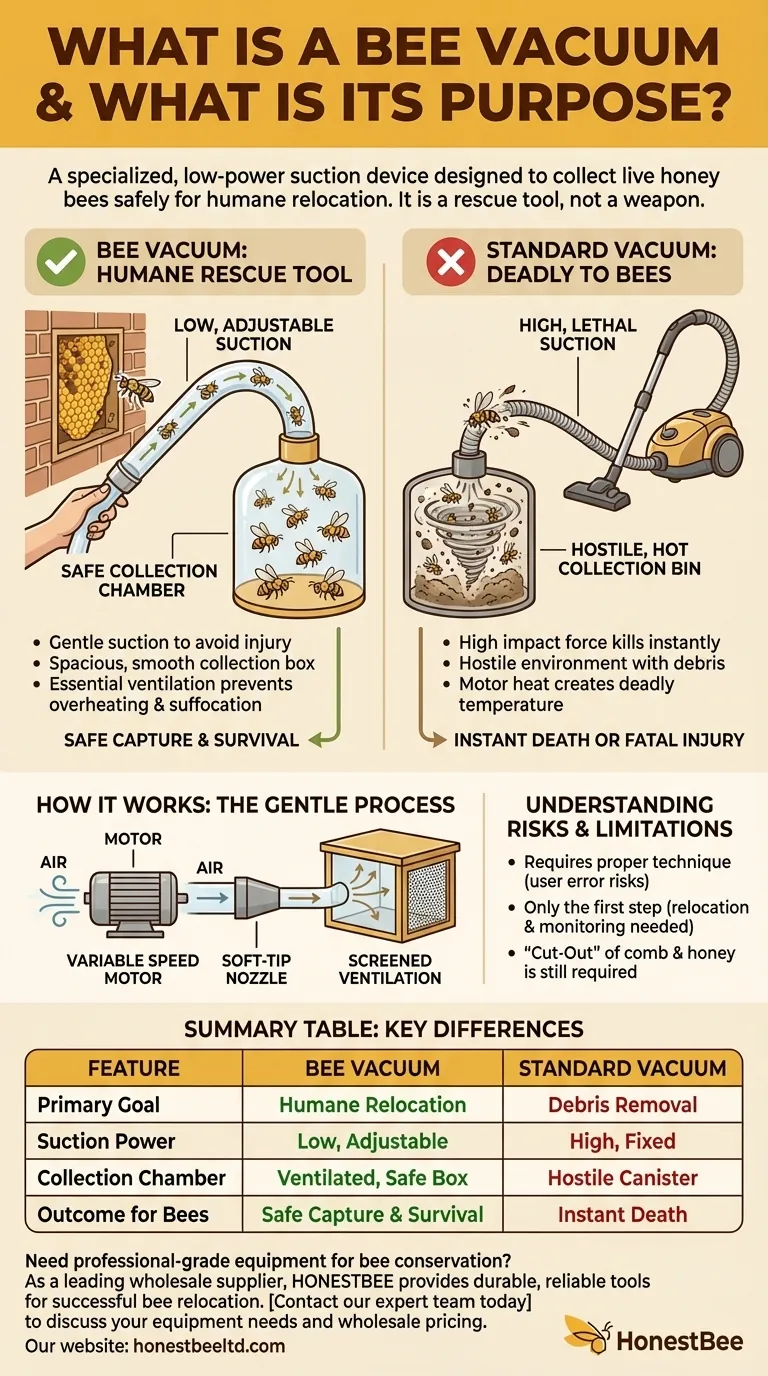At its core, a bee vacuum is a specialized, low-power suction device designed specifically to collect live honey bees without injuring them. Its primary purpose is to enable the safe and humane removal of a bee colony from an unwanted location, such as inside a wall or structure, so it can be relocated. It is a tool for conservation and beekeeping, not extermination.
The most critical thing to understand is that a bee vacuum is not a weapon against bees, but a rescue tool. Its design prioritizes the bees' survival above all else, making it fundamentally different from any standard household or shop vacuum.

Why Standard Vacuums Are Deadly to Bees
Many people first wonder if they can simply use a shop vacuum for bee removal. This approach is guaranteed to kill the entire colony and should never be attempted for honey bees.
The Problem of Suction Power
Standard vacuums are engineered for high suction to pick up heavy debris. This level of force is lethal to a delicate insect. Bees are instantly killed or fatally injured upon impact with the hose or collection bin wall.
The Dangers of the Collection Bin
A typical vacuum canister is a hostile environment. Bees that somehow survive the initial suction are subjected to a whirlwind of dirt and debris, which damages their wings and bodies. Furthermore, the heat generated by the vacuum's motor can quickly raise the temperature inside the bin to deadly levels.
How a Bee Vacuum Works
A bee vacuum is purpose-built to solve these problems. Every part of its design is centered on the safe capture and temporary housing of the bees.
Gentle, Variable Suction
The most important feature is a low-power motor, often with adjustable suction. This allows the operator to use just enough force to draw the bees into the hose without slamming them against surfaces. The goal is to gently guide them, not violently suck them up.
A Safe Collection Chamber
Instead of a simple bin, a bee vacuum deposits bees into a specially designed collection box or hive body. This chamber is large, has smooth interior walls, and provides ample space for the bees to cluster safely, away from the direct force of the vacuum.
Ventilation is Essential
The collection chamber is always well-ventilated. This prevents the bees from suffocating and allows heat to dissipate, ensuring the colony remains at a safe temperature while the removal process is underway.
Understanding the Risks and Limitations
While a bee vacuum is the correct tool for the job, it is not foolproof. Success depends on proper technique and understanding its role in a larger process.
The Risk of Improper Use
Even with a bee vacuum, user error can harm bees. Using too much suction, leaving the unit in direct sunlight, or running it for too long can stress or kill the colony. The operator must remain attentive to the bees' well-being throughout the process.
It Is Only One Part of the Process
A bee vacuum only accomplishes the first step: getting the bees out of the structure. You must have a plan for what comes next. The collected bees need to be transferred to a permanent hive, provided with food, and monitored to ensure the queen is present and the colony re-establishes itself.
The "Cut-Out" Is Still Required
Simply vacuuming the bees is not enough. The honeycomb, brood, and honey left behind in the structure must be physically cut out and removed. If left, the decaying comb and honey will attract pests like rodents, moths, and other insects, creating a new problem.
Making the Right Choice for Your Goal
Your objective dictates the correct course of action. Using the right tool begins with understanding your goal.
- If your primary focus is humane relocation: A bee vacuum is the essential tool for safely collecting bees from a structure as part of a complete hive removal and relocation.
- If you are dealing with a swarm in a cluster: A vacuum is often unnecessary. A swarm is a docile, temporary cluster of bees that can usually be collected by a beekeeper into a simple box or bucket.
- If you are certain you are dealing with pests like wasps or hornets: A bee vacuum is the wrong tool. Its purpose is preservation, not pest control.
Understanding the function of a bee vacuum is the first step toward responsibly managing and conserving these vital pollinators.
Summary Table:
| Feature | Bee Vacuum | Standard Vacuum |
|---|---|---|
| Primary Goal | Humane Relocation | Debris Removal |
| Suction Power | Low, Adjustable | High, Fixed |
| Collection Chamber | Ventilated, Safe Box | Hostile Canister |
| Outcome for Bees | Safe Capture & Survival | Instant Death |
Need professional-grade equipment for bee conservation?
As a leading wholesale supplier to commercial apiaries and beekeeping equipment distributors, HONESTBEE provides the durable, reliable tools you need for successful bee relocation and hive management. Our products are built to the highest standards to ensure the safety of both your team and the vital pollinators you work with.
Contact our expert team today to discuss your equipment needs and wholesale pricing.
Visual Guide

Related Products
- HONESTBEE Professional Long Handled Hive Tool with Precision Cutting Blade
- HONESTBEE Advanced Ergonomic Stainless Steel Hive Tool for Beekeeping
- Professional Dual-End Stainless Steel Hive Tool for Beekeeping
- Premium Wood Framed Metal Wire Queen Bee Excluder
- Full Set Beekeeping Electronic Bee Venom Collector Machine Device for Bee Venom Collecting
People Also Ask
- What are some common uses of a hive tool? Essential Multi-Purpose Tool for Every Beekeeper
- What are the features of a regular hive tool? The Essential Multi-Tool for Every Beekeeper
- What tools are used for cleaning frames? A Beekeeper's Simple 4-Tool Guide
- How should beekeepers handle bees when using a hive tool? Master Calm, Deliberate Techniques
- What is a hive tool and what are its uses? Master Your Hive Inspections with the Essential Beekeeper's Tool



















